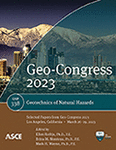Effects of Ground Slope on Site Factors and Development of Adjustment Factors Using 2D FE Analysis for Charleston, SC
Publication: Geo-Congress 2023
ABSTRACT
In engineering practice, one-dimensional seismic site response computer programs were used to estimate the spectral responses at the ground surface, assuming level ground conditions. However, in reality, the ground surface and subsurface layers can be inclined, which may affect the propagation of earthquake waves through soil layers. This study aims to conduct two-dimensional (2D) site response analyses to develop slope adjustment factors to update the site coefficients computed from one-dimensional (1D) analyses for Charleston, SC. Eleven shear wave velocity profiles were generated considering the mean shear wave velocity (Vs) profile, mean ± 1σ (σ = standard deviation) of the natural logarithm of Vs, and variation in the thickness of quaternary soil layers. The modulus reduction and damping curves were developed based on the region-specific relationships. Four earthquake time histories that represented site-specific seismic hazards were selected. Finally, 308 2D finite element models were developed and analyzed considering seven ground inclinations (0o, 1o, 2o, 3o, 4o, 5o, and 6o), 11 Vs profiles, and four earthquake time histories. The results show significant differences between 1D and 2D analyses, justifying the importance of considering sloping ground conditions in seismic analysis to capture the realistic ground motion characteristics at the site. Based on the results, a set of slope adjustment factors were developed for various average shear wave velocities at top 30 m (Vs30) and ground inclination (θ) cases. These slope adjustment factors can account for the mild sloping ground (θ≤6o) effect by multiplying it with site factors obtained from the 1D analysis for their respective combination of Vs30, ground inclination, and spectral period.
Get full access to this article
View all available purchase options and get full access to this chapter.
REFERENCES
Aboye, S. (2013). Seismic site coefficient model and improved design response spectra based on conditions in South Carolina, Ph.D. Dissertation, Clemson University, Clemson SC.
Al Atik, L., and Abrahamson, N. A. (2010). “An improved method for non-stationary spectral matching,” Earthquake Spectra, 26(3), pp.601–617.
Assimaki, D. (2004). Topography effects in the 1999 Athens earthquake: Engineering issues in seismology. Ph.D. Dissertation, Massachusetts Institute of Technology.
Assimaki, D., and Jeong, S. (2013). “Ground‐Motion Observations at Hotel Montana during the M 7.0 2010 Haiti Earthquake: Topography or Soil Amplification,” Bulletin of the Seismological Society of America, 103(5), 2577–2590.
Bhuiyan, M. A. H. (2015). Application of nonlinear site response analysis in coastal plain South Carolina, Ph.D. Dissertation, Clemson University, Clemson SC.
Biscontin, G., and Pestana, J. M. (2006). “Factors Affecting Seismic Response of Submarine Slopes,” Natural Hazards and Earth System Sciences, 6 (1), pp. 97–107.
Boore, D. M. (1972). “A note on the effect of simple topography on seismic SH waves,” Bulletin of the Seismological Society of America, 62 (1): 275–284.
BSSC (Building Seismic Safety Council). (2020). NEHRP Recommended Seismic Provisions for New Buildings and Other Structures, Volume 1: Part 1 Provisions, Part 2 Commentary, Washington, DC.
Chapman, M. C., and Talwani, P. (2006). “Seismic Hazard Mapping for Bridge and Highway Design in South Carolina,”.
Elgamal, A., Yang, Z., Parra, E., and Ragheb, A. (2003). “Modeling of cyclic mobility in saturated cohesionless soil,” Int. J. Plasticity, 19, pp. 883–905.
EPRI/DOE/NRC. (2012). “Central and Eastern United States Seismic Source Characterization for Nuclear Facilities,”, EPRI, Palo Alto, CA, U.S. DOE, and U.S. NRC.
Hashash, Y. M. A. (2011). DEEPSOIL v5.0, User Manual and Tutorial. University of Illinois at Urbana-Champaign, Urbana, IL, <www.illinois.edu/~deepsoil >.
Gheibi, E., Gassman, S., and Talwani, P. (2019). “Regional assessment of prehistoric earthquake magnitudes in the South Carolina Coastal Plain.” Bulletin of Engineering Geology and the Environment, 15p.
Ko, C. P. (2001). Fully coupled site response analysis for mild sloping ground, M.Sc. thesis, Hongkong University of Science and Technology, Hongkong.
Kondner, R. L. (1963). “Hyperbolic stress-strain response: cohesive soils,” J. Soil Mech. and Foundation Engng Div, ASCE, Vol 89, No. 1, 115–143.
McGuire, R. K., Silva, W. J., and Costantino, C. J. (2001). “Technical basis for revision of regulatory guidance on design ground motions: Hazard- and risk-consistent ground motion spectra guidelines,”.
McKenna, F., Fenves, G. L., and Scott, M. H. (2000). Open System for Earthquake Engineering Simulation. University of California, Berkeley, http://opensees.berkeley.edu.
Petersen, M. D., Shumway, A. M., and Powers, P. M. (2020). “The 2018 update of the US National Seismic Hazard Model: Overview of model and implications,” Earthquake Spectra, 36(1), pp.5–41.
Powers, P. M. (2017). National Seismic Hazard Model Project computer code (nshmp-haz), software. Available at: https://doi.org/10.5066/F7ZW1K31 (accessed 16 September 2021).
Taboada, V. M., and Dobry, R. (1998). “Centrifuge modeling of earthquake-induced lateral spreading in sand”, Jour. Geotech. and Geoenviron. Eng, ASCE, Vol 124, No 12, pp. 1195–1206.
Wong, I., Zandieh, A., Hartleb, R., Andrus, R., Rix, G., Carlson, C., Ravichandran, N., Amevorku, C., Jella, V. S., and Harman, N. (2022). “Development of probabilistic seismic hazard maps for the State of South Carolina,” Proceedings, 12th National Conference in Earthquake Engineering, Earthquake Engineering Research Institute, Salt Lake City, UT.
Zhang, J., Andrus, R. D., and Juang, C. H. (2005). “Normalized shear modulus and material damping ratio relationships,” Jour. Geotech. and Geoenviron. Eng., 131(4), 453–464.
Information & Authors
Information
Published In
History
Published online: Mar 23, 2023
ASCE Technical Topics:
- Analysis (by type)
- Continuum mechanics
- Dynamics (solid mechanics)
- Earthquakes
- Engineering fundamentals
- Engineering mechanics
- Finite element method
- Flow (fluid dynamics)
- Fluid dynamics
- Fluid mechanics
- Fluid velocity
- Geohazards
- Geomechanics
- Geotechnical engineering
- Geotechnical investigation
- Hydrologic engineering
- Methodology (by type)
- Numerical methods
- Seismic tests
- Seismic waves
- Shear waves
- Site investigation
- Slopes
- Solid mechanics
- Tests (by type)
- Two-dimensional analysis
- Water and water resources
- Wave velocity
- Waves (mechanics)
Authors
Metrics & Citations
Metrics
Citations
Download citation
If you have the appropriate software installed, you can download article citation data to the citation manager of your choice. Simply select your manager software from the list below and click Download.
